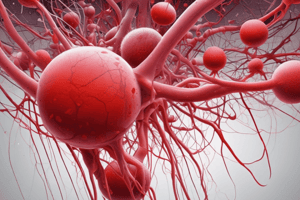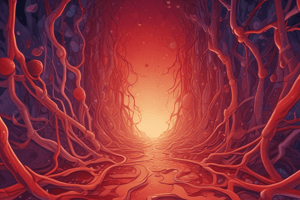Podcast
Questions and Answers
Which of the following does blood not directly transport to maintain homeostasis?
Which of the following does blood not directly transport to maintain homeostasis?
- Enzymes (correct)
- Nutrients
- Oxygen
- Hormones
What is the primary role of phagocytosis in the context of blood function?
What is the primary role of phagocytosis in the context of blood function?
- Regulating body pH
- Protecting against diseases (correct)
- Regulating body temperature
- Transporting nutrients to cells
Which component is not a direct part of the cardiovascular system?
Which component is not a direct part of the cardiovascular system?
- Blood vessels
- Heart
- Lungs (correct)
- Blood
What crucial function is served by interstitial fluid that directly relates to the blood?
What crucial function is served by interstitial fluid that directly relates to the blood?
Which of these is least related to the transportation function of blood?
Which of these is least related to the transportation function of blood?
Which characteristic would not be expected in a healthy blood sample?
Which characteristic would not be expected in a healthy blood sample?
Which of the following blood components is present in the highest percentage in blood plasma?
Which of the following blood components is present in the highest percentage in blood plasma?
Which of these blood plasma proteins plays a crucial role in blood clotting?
Which of these blood plasma proteins plays a crucial role in blood clotting?
What is the role of alpha and beta globulins in blood plasma?
What is the role of alpha and beta globulins in blood plasma?
Why is maintaining osmotic pressure important in blood plasma?
Why is maintaining osmotic pressure important in blood plasma?
What distinguishes red blood cells (RBCs) from white blood cells (WBCs) and platelets?
What distinguishes red blood cells (RBCs) from white blood cells (WBCs) and platelets?
How does the hematocrit value reflect the composition of blood?
How does the hematocrit value reflect the composition of blood?
Which process describes the formation of all blood cells?
Which process describes the formation of all blood cells?
How does hemoglobin contribute to the primary function of red blood cells?
How does hemoglobin contribute to the primary function of red blood cells?
What chemical element is at the center of each heme ring in hemoglobin, enabling oxygen binding?
What chemical element is at the center of each heme ring in hemoglobin, enabling oxygen binding?
What happens to hemoglobin when blood flows through tissue capillaries?
What happens to hemoglobin when blood flows through tissue capillaries?
What is the role of transferrin in the red blood cell life cycle?
What is the role of transferrin in the red blood cell life cycle?
What process in the red blood cell life cycle occurs in the spleen, liver, and red bone marrow?
What process in the red blood cell life cycle occurs in the spleen, liver, and red bone marrow?
How is bilirubin, derived from heme, primarily excreted from the body?
How is bilirubin, derived from heme, primarily excreted from the body?
Which vitamin is essential for erythropoiesis in the red bone marrow?
Which vitamin is essential for erythropoiesis in the red bone marrow?
Flashcards
Blood and Homeostasis
Blood and Homeostasis
Blood’s contribution to maintaining a stable internal environment, by transporting oxygen, carbon dioxide, nutrients, and hormones.
Cardiovascular System
Cardiovascular System
The cardiovascular system consists of blood, the heart, and blood vessels, all working together.
Blood Definition
Blood Definition
Blood is a liquid connective tissue with cells in a liquid extracellular matrix called blood plasma.
Interstitial Fluid
Interstitial Fluid
Signup and view all the flashcards
Functions of Blood
Functions of Blood
Signup and view all the flashcards
Physical Characteristics of Blood
Physical Characteristics of Blood
Signup and view all the flashcards
Blood Plasma
Blood Plasma
Signup and view all the flashcards
Plasma Proteins Functions
Plasma Proteins Functions
Signup and view all the flashcards
Formed Elements
Formed Elements
Signup and view all the flashcards
Hematocrit
Hematocrit
Signup and view all the flashcards
Erythrocytes
Erythrocytes
Signup and view all the flashcards
Hemoglobin
Hemoglobin
Signup and view all the flashcards
Hemoglobin content
Hemoglobin content
Signup and view all the flashcards
Hemoglobin function
Hemoglobin function
Signup and view all the flashcards
Erythropoiesis
Erythropoiesis
Signup and view all the flashcards
Study Notes
- The cardiovascular system contributes to homeostasis.
- The system transports oxygen, carbon dioxide, nutrients, and hormones to and from body cells.
- It also regulates body pH and temperature.
- It provides protection against disease through phagocytosis and the production of antibodies.
Functions and Properties of Blood
- The cardiovascular system is composed of three interrelated components: blood, the heart, and blood vessels.
- Blood's functions include transportation (oxygen, CO2, hormones, waste products) , regulation (body temp, pH, hormones), and protection (platelets, WBCs).
- Blood is a liquid connective tissue consisting of cells surrounded by a liquid extracellular matrix.
- The extracellular matrix is called blood plasma which suspends various cells and cell fragments.
- Interstitial fluid is the fluid that bathes body cells and is constantly renewed by the blood.
- Blood is denser and thicker than water, with a temperature of 38°C (100.4°F) and a pH between 7.35-7.45
- Blood volume is 5-6L in males and 4-5L in females
Components of Blood
- Whole blood consists of 55% blood plasma and 45% formed elements.
- Blood plasma is 91.5% water, 7% proteins, and 1.5% other solutes.
- Water in blood plasma acts as a solvent and suspending medium, absorbing, transporting, and releasing heat.
- Plasma proteins are mostly produced by the liver and include albumins (54%), globulins (38%), fibrinogen (7%), and all others (1%).
- Albumins are the smallest and most numerous plasma proteins, responsible for colloid osmotic pressure, blood viscosity, transport.
- Globulins help maintain osmotic pressure and attack viruses and bacteria.
- Fibrinogen plays an essential role in blood clotting.
- Other solutes in blood plasma include electrolytes, nutrients, gases, regulatory substances, and waste products.
- Formed elements of blood include red blood cells (RBCs), white blood cells (WBCs), and platelets.
- Hematocrit refers to the percentage of total blood volume occupied by RBCs
- Normal hematocrit range for adult females is 38-46% (average = 42), and for adult males is 40–54% (average = 47).
Formation of Blood Cells
- Blood cells are formed from progenitor cells, precursor cells, formed elements of circulating blood, and tissue cells
Red Blood Cells
- Red blood cells (RBCs) or erythrocytes contain hemoglobin which gives whole blood its red color
- A healthy adult male has about 5.4 million red blood cells per microliter (µL) of blood, and a healthy adult female has about 4.8 million.
- Each RBC contains about 280 million hemoglobin molecules.
- A hemoglobin molecule consists of a protein called globin, composed of four polypeptide chains
- A heme is bound to each of the four chains.
- At the center of each heme ring is an iron ion (Fe2+) that can combine reversibly with one oxygen molecule, allowing each hemoglobin molecule to bind four oxygen molecules.
- Each oxygen molecule picked up from the lungs is bound to an iron ion.
- As blood flows through tissue capillaries, the iron-oxygen reaction reverses and hemoglobin releases oxygen.
Studying That Suits You
Use AI to generate personalized quizzes and flashcards to suit your learning preferences.




